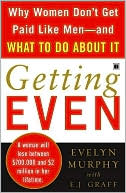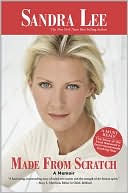Getting Even: Why Women Don't Get Paid like Men - and What to Do about It
Search in google:
A WORKING WOMAN EARNS 77 CENTS FOR EVERY MALE DOLLAR. In the twenty-first century, the gender wage gap still affects the daily life of women throughout the country, at every economic level, from cashier to CEO. Is it fair? No. Can it be stopped? Absolutely. In this intelligently argued and carefully researched book, Evelyn Murphy, Ph.D., examines how much women (and their families) lose over a lifetime to the wage gap, knocks down the myth that women "choose" to make less, and documents the widespread discrimination that's holding down women's pay. But here's the good news: The wage gap can be closed. Having served as an economist, politician, public official, and corporate officer, Murphy has a 360-degree view of the problem — and of the solution. Read this book — and get even. Publishers Weekly More than 40 years after the Civil Rights Act prohibited gender bias in the workplace, women are still earning almost 25% less than comparably employed men. For Murphy, the reason why is obvious: persistent unintentional, and sometimes even intentional, discrimination. "Today's conventional wisdom about what causes the gender wage gap ignores anything that happens behind employers' doors," Murphy, who has a doctorate in economics and is a former lieutenant governor of Minnesota, points out. To open those doors, she examined scores of recent lawsuits, which provided her with more than 200 pages worth of stories and statistics guaranteed to convince even the most satisfied working woman that on-the-job discrimination is "still with us, and it's not going away on its own." Murphy, with the help of Graff, a senior correspondent for the American Prospect, analyzes five types of discrimination-"blatant sex discrimination, sexual harassment, workplace sex segregation, everyday discrimination and discrimination against mothers"-and calculates that, over a lifetime, each working woman loses between $700,000 and $2 million because of them-that means less money for bills, homes, investments and retirement plans. As an antidote, the book's last third offers detailed case studies of MIT, Mitsubishi and the state of Minnesota, working sites that, under pressure, implemented large-scale changes to address inequities. Murphy gives readers the tools and the inspiration they'll need to tackle individual discrimination issues without necessarily going to court, but her goal is obviously larger than that. As the president of the WAGE Project, she aims to rile the public at large into action so that the wage gap can be closed, for good, in the next 10 years. (Oct.) Copyright 2005 Reed Business Information.
Contents Part 1: Why Not a Dollar? Chapter 1: Introduction Chapter 2: Why Not a Dollar? Chapter 3: The Personal Cost of the Wage Gap: A Second-Class Life Part 2: Now Add Discrimination Chapter 4: Cents and Sensibilities Chapter 5: Plain Old Discrimination Chapter 6: Wage Discrimination by Sexual Harassment Chapter 7: Women¹s Work Chapter 8: Everyday Discrimination: Working While Female Chapter 9: Working While Mother: The Mommy Penalty Part 3: Getting Even Chapter 10: No More Excuses Chapter 11: Starting to Get Even Chapter 12: Women, Working from the Inside Up Chapter 13: CEOs, Working from the Top Down Chapter 14: All of Us, Working from the Outside In Notes Acknowledgments Index








